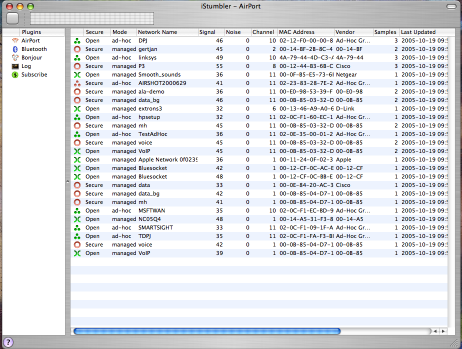After long, arduous hours of research:”(Which is to say, I came in a half-hour early on Friday)”: the crack:”(Or, possibly, on crack)”: research team at the Asbury College office of Information Services has assembled a fully funcioning Redundant Array of Independent Coffee Machines (RAICM).
[Complete photo gallery here]
Constructed of 6 coffee machines, and one emergency backup unit, the RAICM array is able to churn out more than 50 gallons of coffee an hour. The machines are interconnected via CAT5 (CAT stands for Columbia, Antigua, Tanzania), through a 10/100 MBPS switch, communicating by RCP (Remote Coffee Protocol). Each coffee machine was retrofited with one PCI (Percolation Control Interface) slot into which we could wedge an ethernet card for this purpose. The smallest coffee maker was too small to get the PCI card into it, so it was forced to communicate over PCP (Parallel Coffee Protocol).
On the cluster there is also a wireless access point, so that coffee may be obtained wirelessly. We recommend the use of SCP (Secure Coffee Protocol) for this type of access, to prevent injection attacks, which the FDA may well consider illegal.
Controlling the entire array is the CPU (Central Percolation Unit) which was constructed from a very elderly Toshiba Satellite laptop, sporting a 386 processor and a whopping 4MB of RAM. From this unit, the coffee pots can be monitored, coordinated, and scheduled. Alas, for our demo, we had a hard drive failure, and the CPU wouldn’t boot. We suspect that it had consumed Juan cup of coffee too many. After all, it was, by then, pretty latte in the morning.
However, we can let you in on a few little secrets about the CPU and how it works. All of the controlling software is, of course, written in Java. The scheduling engine, rather than using cron, is done via a Java Script. And communication between the CPU and the various members of the array is done exclusively via Net Beans. The user interface that was designed relies heavily on the CSS standard (Cream, Sugar, Stir).
Several of the units, as you can see in the pictures, had updated processors installed for this experiment. And we even installed two hard drives on the array, so that it can store preferences for each coffee maker. These drives are, of course, IDE drives (If Decaf, Eject). We did experiment briefly with a CD drive (Caffienated/Decaffienated) but found that most of our engineers were so hopped up that they were spinning faster than the disks. Note also that several of our colleagues experimented with DASD (Decaf And Semi-Decaf) but we think that’s just silly.
Several of the coffee makers are directly interconnected to provide full failover in the event that someone discovers one of the coffee makers to have run out before they get their third cup.
The conclusions of our experiments are as follows:
1) Geeks with too much time on their hands are likely to spend it doing very silly things.
2) Certain persons should not be entrusted with delicate equipment
3) When something stops working, you probably should go ahead and throw it away, even though, to quote one of our esteemed colleagues, “We might could fix it some day!”
4) No matter how fine the equipment is that you give people, some folks will still insist on drinking bad coffee.
Other gratuitous remarks
* It is important that you have good filters in place.
* Notice that the CPU has a cereal interface
* This picture illustrates the cafe press
* Always choose the right tools when performing case modifications
* This series of pictures illustrates the well-known “blinking 12” problem
* Always wear appropriate safety gear
* This picture shows two of the non-volatile off-site backup storage units.

